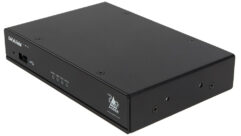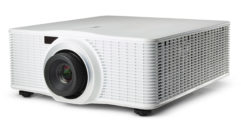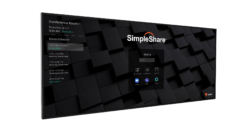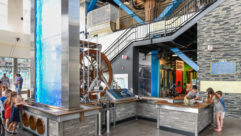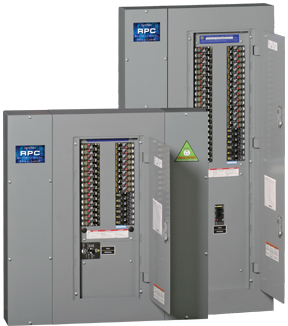
SVC Podcast – Show Notes – Show 173-1
In this edition of the SVC Podcast, Contributing Editor Bennett Liles talks with Alan Tschirner of Lyntec about the state of the power grid and implementing AC power control and monitoring. Alan also comments on the importance of protecting the power supply of all AV equipment from voltage transients and surges. He also stresses the importance of keeping sound, video and lighting gear on separate legs of the power.
For Part 2
Links of interest:
- Lyntec – Manufacturer of industrial breaker panels and power management and load sequencing products
- Lyntec automated load sequencing control panels
- Lyntec videos
Download Podcast Here:
https://s3.amazonaws.com/nb-svc/public/public/173-1_Power_Lyntec_Tschirn…
This is the SVC Podcast from Sound & Video Contractor Magazine with Alan Tschirner of Lyntec. Show notes and equipment links for the podcast are on the web site of Sound & Video Contractor Magazine at svconline.com.
Video, lighting, network and sound. They all have to speak power and now we have some power experts to give us the story on what’s happening to electrical power and how it can be better controlled and managed for AV. Alan Tschirner from Lyntec is going to tell us all about it. That’s coming right up on the SVC Podcast.
Alan it’s good of you to join us on the SVC Podcast from Lyntec, power experts and manufacturer of power-control equipment. It’s good to have you on the podcast with us.
My pleasure, Bennett. Thank you.
Lyntec is into industrial level breaker panels and power management so it’s a great place to start on this. What’s been happening at Lyntec lately?
Well, the products continue to evolve, Bennett. Continuous improvement is our motto. Taking feedback from our customer base, looking how to improve products we have or how to develop new products, and we have some pretty exciting developments right now. The RPC, which has been the flagship of our product line both in motorized circuit breakers and then a couple of years ago we brought it out as a relay panel for retrofit applications, some of the feedback we’ve had from our customers is about the delay settings or the step rates in between the individual circuit timing, which is unique to us in that interface. But one of the observations or the feedback was hey, your set rates are nice but there are opportunities or times that I need a specific setting that’s not in your list. What can we do? Well, to that we’re introducing the first of next month the product that ships will have a custom delay time so that time can be set for a user-selectable length or duration of one second to 999 seconds. And this is driven mostly by digital audio systems or digital boards and snakes where there’s a very specific rate at which the equipment needs to be sequenced and the order that it needs to be sequenced for everything to communicate. So if you need 43-second delay and you don’t want to wait a full minute for that then enter 43 seconds as your custom delay time and you’re all set to go. [Timestamp: 2:32]
Alright.
Also at LDI last year we were demonstrating our 0-10 dimming output board for the RPCR, the RPC series. It’s a translator from an incoming DMX level to a 0-10 volt level for those light fixtures that use a 0-10 synching control system. So that will be out later this quarter, so we’re excited about that. And another RPC upgrade is the addition of an over-voltage protection setting. And that’s the mirror of the – we’ve always had an under voltage or a brownout protection setting, and now we’ve gone in the other direction and set a threshold that if the voltage exceeds a set point then those circuits that are identified can be turned off until the voltage settles back down again. It hasn’t been much of a problem in the U.S., but as we expand our market coverage into Mexico and other countries the feedback is, “Our power is not as stable as you enjoy in the U.S. so we need that protection.” [Timestamp: 3:39]
On this podcast we talk about audio, video, networks and lighting, they all have come together at the power and that’s the universal language they all have to speak at some point. That makes them all vulnerable to power issues on the grid. What’s been going on with power in the United States over the past few years? Has it gotten better or worse? Is it more noisy now with switching power supplies being used everywhere? What’s the general state of power?
The industry will tell you demand is up, supply is down so quality is suffering. It doesn’t take more than picking up a newspaper here reading about another power plant that’s being shut down or a plant that didn’t receive an approval to be built, so we’re stretching the grid pretty thin. And as a result we’re seeing more and more UPS installations or uninterruptable power supplies being included in installations to protect sensitive equipment from things that happen in the power grid. Or switching power supplies, the wasted power or not every watt the customer buys is being used in the equipment. Some of it is being wasted as heat and harmonics and other anomalies in power. So it’s not a pretty picture at the moment, but we’re trying to address it with more control options and to take care of it at the circuit level. [Timestamp: 5:04]
So all the more important that you have good AC and monitoring because it affects all of the AV and network systems. You’ve been in the business for a long time. Where was remote power control and monitoring first concentrated? Was that in data centers?
Well, it’s interesting. It goes as far back as remote-control lighting in schools and offices with the relay-type solutions all the way back to the 60’s. And then we are a Square D OEM so all of our motorized circuit breaker products are either the Square D first or third generation product. And in preparation for this interview I reached out to them and asked the question where they came from. The short but interesting story was the motorized square D circuit breaker was developed for a smart house project in the 80’s as a showcase for I think it was a home builder’s association that was championing that project at the time. And from that then some of the major retailers in the country saw an opportunity to use that technology in their retail stores for remote control of the lighting. That created the volume, so then we’ve been using motorized circuit breakers since the 90’s. I don’t know if you remember back in Lyntec’s history we were originally an audio control and processing company with Crowd Comp and some of the other products that were filling a need for larger and larger installations. So the whole power control part of the company started from the audio design community building and designing more and more complex systems that needed simple control interfaces so that in the case of a church application operated by volunteers or in the school operated by students. So they needed a way to protect the owner’s investment in their more elaborate and more complex audio/video systems that are operated by people who are well-meaning but not necessarily well-trained. So here we are. [Timestamp: 7:04]
Well, let’s apply this to a particular market. Let’s say the house of worship environment. How can church AV operations benefit from a unified power control structure?
Well, that says it. It’s providing the simplified control is an investment protection from a couple of angles. It reduces the likelihood of equipment being damaged by the power being applied in the wrong order. In other words, if power amplifiers are turned on before the pre-amplifiers or digital signal processing there can be pops and thuds and clicks that will physically damage loudspeakers. So that goes all the way back to the beginning of “Don’t let my speakers click.” So beyond that as the systems evolved from straight audio into the lighting and video wall LED systems now the issue is protect my investment by allowing me to turn the equipment off and remove from this power grid. A typical house of worship, in a 30-day period they may use it for 20 or 25 hours. So the rest of the time the LED lighting fixture, power supplies are idling so they’re using power. They’re exposed to lightning strikes and power anomalies and brownouts and other things that happen to the system. So extend the life of the investment by turning them off when they’re not being used. [Timestamp: 8:25]
And with most of the smaller churches it’s probably the same as in a lot of other places. They’ve just got one big rocker switch and THUMP. It’s all on or all off.
Right. And back to your question about what’s new at Lyntec is everything that we have learned about power control, one area that we have not addressed is the rack mount and we are fixing that. We have a product that the project name is SEQR or sequence – SEQR – rack unit that will sequence up to four 20-amp circuits in either four or eight steps all in a two-rack unit box. So all of the control and programming interfaces that our RPC designers and installer community is fond of. So we’re pretty excited about that coming out here shortly. [Timestamp: 9:16]
Well, this is something I’ve worked on myself on quite a few projects. What precautions should you take from the outset to make sure that power, lighting video and sound all work well together?
Plays well with others. The easiest way to make the AV and the lighting system work well together is to keep them apart and that’s through up-front design and the inclusion of isolation transformers to keep the noisy sources and noise being, switching power supplies and motor loads and even the Hobart mixer in the kitchen isolated from the power grid that feeds the audio and the video systems. They’re more robust than they used to be but they still depend on clean, consistent power. So isolation is a big part of it, grounding is a part of it, but it all comes down to a well-thought-out design in many cases and corporate bringing someone in who that’s their business making systems work well so that all the parts in the system work well together. [Timestamp: 10:20]
Yeah, and when you’ve got a temporary installation going up for an event or something and end up chasing ground hum and that can go beyond the physical and almost get to alchemy sometimes. When you do get ground hum, what things should be done to isolate and cure that problem? And the same for hum bars in video displays.
It’s so specific to each installation and each correction. You’re right, it comes from experience. If this doesn’t work, do that. I’m sorry I don’t have the magic bullet to make hum go away, but everything from isolation transformers to humbuckers to moving power feeds around, changing phases, it’s more the art than the science especially on a mobile. [Timestamp: 11:05]
Usually it’s easier to isolate audio with transformers than to be moving power around. I always do that as kind of a last resort.
Right. It’s all different levels.
So when you’ve got bad power, lots of outages, transients, over and under voltages, what sort of effects can repeated power trouble have on AV and lighting systems?
Ultimately premature failure. The power is in the power supply. The power supply is the first shock absorber, for lack of a better description. But that’s what takes the sag, that’s what takes the over-voltage, that’s what takes the drop-out. I mean you restart all of that and it is injurious to the power supply. Even in LED lighting fixtures power supplies fail much sooner than the semiconductors and the actual LED’s are emitting the light. So it’s all about protecting the power supply. And again, back to the conversation about why you switch the power off to these devices is exactly that. It’s not that three to five percent of the time that you see bad power, it’s the other 95 or 97 percent of the time when you’re not there but the devices are still exposed to bad power. [Timestamp: 12:09]
But it always leaves the evidence behind whether it’s obvious immediately or not.
Right. The installation of remote power controls seems pretty straight-forward in single point. Adjacent, either in place of or as the breaker panel or on retrofits adjacent to the panel to simplify the wiring. Everything has to be plugged in at some point so maybe you’re adding your power control at the panel and you’re avoiding electricians or cherry-pickers running wire around the facility to go to remote outlet boxes or some of the other solutions that are out there. [Timestamp: 12:44]
All right. Well, this has been good. I’ve been looking forward to having a talk about power with the experts and I think the long term effects of bad power have been overlooked quite a bit. It’s been fun having you here. Alan Tschirner from Lyntec, experts in power control and management. Thanks for taking time for us today, Alan.
Well, Bennett, thank you very much for the opportunity. It’s been a pleasure being part of the podcast.
And thank you for joining us on the podcast. Show notes and equipment links are on the website of Sound & Video Contractor Magazine at svconline.com. Next week we’ll be going further into power control and management with E2i Designs. That’s on the next SVC Podcast.



